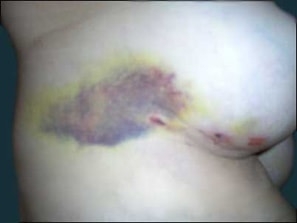Plastic surgery is gaining momentum and is becoming more and more in demand. And the number of people who want to improve their appearance is increasing. The most common reason women see a plastic surgeon is breast augmentation or breast augmentation. Someone wants to increase the size, someone wants to see their breasts in a different shape, and some want to increase the areola of the nipple. All these desires are fulfilled surgically. Like any other surgery, breast plastic surgery has some complications, the main one being seroma.
What is a seroma? When does seroma appear?
A seroma is a collection of serous fluid after surgery. Seroma usually forms after surgeries that require large incisions. That is, more often seromas occur after breast plastic surgery, abdominoplasty, and also after body and face lifting.
Serosal fluid is a straw-yellow liquid that has varying viscosities. Seroma consists of a liquid part and shaped elements. Formed elements are represented by macrophages, mast cells and leukocytes. The liquid fraction contains albumin proteins, globulins. In operations that are accompanied by massive separation of subcutaneous tissue and a large wound surface, the risk of seroma formation increases.
Causes of seroma after breast augmentation

The main reason for the accumulation of serous fluid after breast augmentation is the violation of the integrity of the walls of the lymphatic vessels during the operation. It is believed that seroma appears only when the fluid released from the lymphatic vessels becomes inflamed. This is confirmed by the fact that during most operations, lymphatic vessels are damaged, but not after every operation, a seroma appears. That is, seroma appears as a reaction to trauma to the blood and lymphatic vessels during surgery. Often the seroma resolves on its own in a few days, and the patient may not even notice its presence.
Some seromas can resolve for several weeks. This is accompanied by stretching of the tissues, sagging of the skin. These phenomena cause discomfort, discontent and anxiety. The skin above the gray may be slightly reddened and have an elevated temperature. Sometimes, when a large seroma appears, the patient may feel the fluid rolling over when changing body position.
Other causes of seroma:
- Excessive use of coagulation during surgery. Coagulation is a tissue burn. It is known that the burn is accompanied by tissue necrosis and the release of inflammatory fluid, that is, exudate. Therefore, in surgical practice, coagulation should only be used to cauterize bleeding vessels.
- Traumatic tissue handling. When working with soft tissues of the body, the surgeon must be as accurate and careful as possible. Rough work not only increases the risk of seroma formation, but also increases the time of the operation and increases the risk of bleeding during and after the operation.
- The patient has a large thickness of subcutaneous fat. With a subcutaneous tissue thickness of more than 5 cm, the risk of seroma is very high.
Breast surgery is a surgery that often results in seromas. This is due to the fact that during breast surgery, the likelihood of damage to the lymph nodes is high, since it is in this part of the body that there are many of them.
Prevention and treatment of seroma after breast augmentation
Currently, a large number of surgical methods and instruments have been developed in order to reduce vascular injury during operations, including breast surgery. If, nevertheless, a seroma has formed, it can pass on its own. But if the seroma is large and enlarges, it must be treated immediately. Untreated seroma turns into a dense knot.
The treatment for seromas is to remove them. Large seromas are removed by suction of fluid from them with a special needle. With inefficiency such seromas are removed using vacuum drainage. Against the background of this treatment, it is advisable for the patient to prescribe antibiotic therapy, since seromas can become infected. Only in some rare cases, a seroma requires surgical treatment.
The best solution to a problem is to prevent it. So, gray can be prevented by drainage. Even short-term drainage can prevent the appearance of seroma after operations, including breast surgery. Some surgeons often use compresses, which has a positive effect.
Breast surgery is a surgery that allows a woman to see her breasts the way she wants. But before the operation, the surgeon must explain the possible complications after breast augmentation.






Add a comment